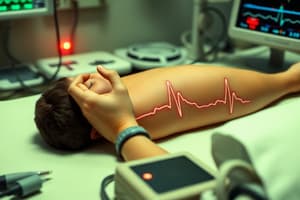Podcast
Questions and Answers
A patient with unstable tachycardia and a narrow QRS complex (≤0.11 seconds) does not respond to an initial 12mg dose of adenosine. What is the next recommended step?
A patient with unstable tachycardia and a narrow QRS complex (≤0.11 seconds) does not respond to an initial 12mg dose of adenosine. What is the next recommended step?
- Proceed directly to synchronized cardioversion, considering sedation. (correct)
- Administer a second dose of adenosine at 18mg IVP/IO.
- Initiate an amiodarone infusion at 150mg over 10 minutes.
- Perform a vagal maneuver and reassess the rhythm.
You are preparing to perform synchronized cardioversion on a patient with unstable tachycardia. Which of the following is a crucial step to consider before initiating the electrical shock?
You are preparing to perform synchronized cardioversion on a patient with unstable tachycardia. Which of the following is a crucial step to consider before initiating the electrical shock?
- Administering a bolus of intravenous fluid to increase preload.
- Confirming that the synchronizer mode is activated on the defibrillator. (correct)
- Ensuring the patient has received a full paralytic dose of neuromuscular blocking agent.
- Pre-oxygenating the patient with 100% oxygen via a non-rebreather mask is unnecessary.
After the first synchronized cardioversion attempt, a patient's heart rhythm remains unchanged. What should be the immediate next action?
After the first synchronized cardioversion attempt, a patient's heart rhythm remains unchanged. What should be the immediate next action?
- Administer a dose of intravenous amiodarone and reassess in 5 minutes.
- Increase the dose of the next synchronized cardioversion and reassess the need for further sedation. (correct)
- Switch to unsynchronized cardioversion (defibrillation) due to the persistent rhythm.
- Start a dopamine infusion to support blood pressure.
A patient with unstable narrow complex tachycardia requires sedation prior to synchronized cardioversion. What is the recommended initial dose of Etomidate for sedation in this scenario?
A patient with unstable narrow complex tachycardia requires sedation prior to synchronized cardioversion. What is the recommended initial dose of Etomidate for sedation in this scenario?
What is the primary rationale for using synchronized cardioversion, as opposed to unsynchronized cardioversion (defibrillation), in a patient with unstable tachycardia?
What is the primary rationale for using synchronized cardioversion, as opposed to unsynchronized cardioversion (defibrillation), in a patient with unstable tachycardia?
Flashcards
Synchronized Cardioversion
Synchronized Cardioversion
A procedure to deliver a controlled electrical shock synchronized with the patient's QRS complex to terminate unstable tachyarrhythmias.
Adenosine
Adenosine
A medication used for rapid heart rates to slow down electrical activity in the heart.
Etomidate
Etomidate
A drug used to provide sedation during medical procedures.
Cardiac Monitor
Cardiac Monitor
Signup and view all the flashcards
Vascular Access
Vascular Access
Signup and view all the flashcards
Study Notes
- Tachycardia is present in an unstable patient demonstrating mental status changes and lacks a palpable radial pulse
General Adult Assessment
-
Cardiac monitor
-
Vascular access
-
Identify if the QRS complex is narrow (≤ 0.11 sec)
-
If IV is established, administer 12 mg of adenosine rapidly IVP/IO
-
Verify if there is a rhythm change
- If the rhythm change is a No, then perform synchronized cardioversion
- Consider sedation using Etomidate at 0.15 mg/kg IV/IO
-
Verify if there is rhythm change after cardioversion
- If the rhythm change is a No, repeat synchronized cardioversion. Assess need for repeat sedation
Studying That Suits You
Use AI to generate personalized quizzes and flashcards to suit your learning preferences.




